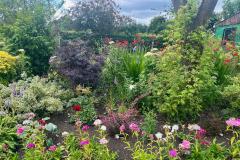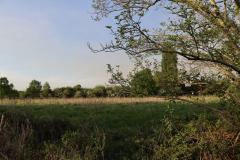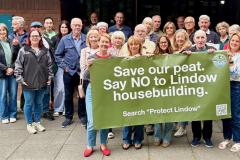An ecological consultant who specialises in water vole conservation has described the peat extraction at Lindow Moss as 'simply devastating' and calls for the rare habitat to be restored.
Derek Gow was commissioned to visit the site, also known as Saltersley Common, on Thursday 12th November by the Saltersley Common Preservation Society. Derek originally visited Lindow Moss in 2010 to carry out a water vole survey for SCPS, which was formed in the late 1990's and campaigns to protect the Moss.
Tony Evans, Secretary of SCPS, explained "SCPS originally commissioned Derek to do a comprehensive water vole survey in 2010. It ran to roughly one hundred pages with text and photographs and concluded that the moss was a mess and the responsibility lay with the council and the operator.
"We gave copies to various officials at Cheshire East Council but would bet that most made their way into the bin. They were totally ignored, as we have been, and the Council insisted, even until a couple of weeks ago, that there wasn't a problem. That is why we commissioned Derek to come and have another look."
Speaking about his recent findings Derek Gow told wilmslow.co.uk "There has been a change, the habitat has got much worse. Due principally to drainage and overshading from birch scrub.
"Peat extraction is simply devastating. What should be a raised mire with dragonflies, water voles, lizards and birds like nightjars, stonechats, etc is basically just destroyed. Even where tiny patches of habitat remain they are just minute, imperilled by future extraction and too small to host any abundance of natural life.
"I found water voles in a single pool system in the northern corner of the site. In areas where they had been formerly abundant there were no field signs of their presence."
Speaking about his recommendations for the moss, Derek said "An immediate sincere discussion should begin between the site owners and all interested parties with a view to stopping drainage and creating a structured process of habitat restoration. Although it can never be returned to what it was - these habitats are ancient landscape features - much could be accomplished.
"The heather could be restored, scrub cot back, piled logs used to form reptile habitats, more linked pool systems created to provide for water voles and other aquatic life. The area was and should be again a brilliant community resource which people can use and enjoy. These habitats are rare and really with a bit of imagination it could be restored to form an absolutely brilliant community asset."
Additionally, a survey carried out by two Wildlife Trust members in September concluded that the general wildlife value of this rare raised bog has been largely destroyed by on-going industrial peat mining.
The report stated "While water voles were historically common here, no prime habitat remains. The ditch systems in which water voles previously occurred have lost their value by being allowed to dry out, become overshaded by growth of birch or willow on their banks, had their vegetation stripped out by drainage work, or been obliterated by peat extraction operations
"Excavation work (which in some places has reached the underlying sand sub-strata) has resulted in severe reduction in the water table and dying-out of the site.
"There is no evidence of any work being undertaken to maintain the suitability of the site for water voles, except for the 70 meter long ditch at the northern boundary of the CWT reserve. Although water is artificially held in this ditch, it is unsuitable habitat in other respects, and no water vole field signs have been recorded here in previous reports, nor in the current survey."
Tony Evans said "My opinion is that the council started digging themselves into a hole in 2003 and now we are left with one 14 foot deep over 25 acres or more due to a total lack of control and competence. This was predicted 15 years ago and will get worse before it gets better."
He added "I should also mention that in February this year we reported another breach of condition. Condition 31 says no sand must be disturbed. In the north eastern corner of the site there is sand on the surface and in the ditches (go to google earth where it is plainly visible). This is enabling the water to drain more freely.
"Caroline Simpson of Cheshire East replied that they were calling for a meeting with the operator. I checked in August to ask about the outcome and Ms. Simpson replied that the 'operator declined a meeting'. I wrote back to ask who exactly runs the site."
Croghan Peat Industries Ltd of Meare, Somerset purchased the Moss in 1997-8. In December 2014 they submitted two planning applications, to build 14 detached houses on part of Lindow Moss and restore the 28 hectares peat extraction site to a natural wetland habitat.
The first application, reference 15/0064M, is for the 28 hectare peat extraction site and the second application,15/0016M, relates to an area of 1.763 hectares to the south of the peat bog.
The owners of the land Andrew Rowland and Richard Bond are proposing that peat extraction ceases once planning permission for the houses is granted and Lindow Moss is restored as a matrix of peatland wetland habitats by encouraging the return of native flora and fauna and enhancing the range of habitats which already exist. The processing area would then be replaced with a development of 14 sustainable family homes.
The two planning applications were expected to be decided in March and April of this year yet both are yet to be determined. I am currently awaiting a response from Cheshire East Council regarding why the decisions have been delayed.
Planning permission for peat extraction on Lindow Moss was granted by five separate permissions between 1959 and 1967, which expire in February 2042. At present the western part of the peat extraction area must be restored either to a nature conservation after use or an amenity that promotes nature conservation. The eastern section must be restored to agricultural after use by backfilling.
Updated: Tuesday, 24th November 3.49pm. A spokesman for Cheshire East Council said: "With regard to the planning application for a housing development at Lindow Common, we are awaiting further information from the proposed developers and no date has yet been fixed for an application to go before the planning committee.
"The Council continues to monitor the site on a regular basis and we continue to discuss any concerns with the peat extraction operator, whilst monitoring the site in relation to any impact on wildlife including water voles."














Comments
Here's what readers have had to say so far. Why not add your thoughts below.
I can confirm that no-one from CE has done a Water Vole Survey and our hydrologist reported that the water table has dropped.
Regarding the housing, would you buy a house on the edge of a subsiding peat bog where the land has dropped 2ft or more in six years? More importantly, would you be able to get insurance.
When George Osborne suggested we write to DEFRA about the problem we gave up after receiving replies referring to Lindow Common.